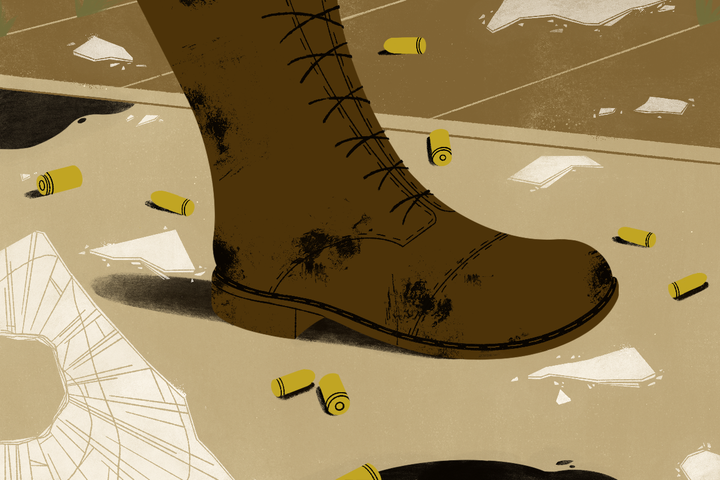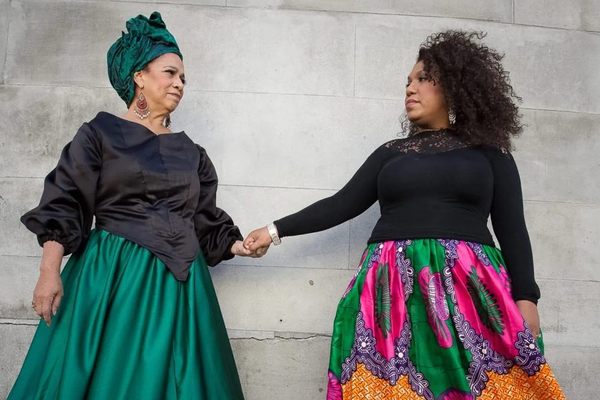
Were Black GIs Killed in a World War II–Era Race Riot?
Louisiana locals and historians are both commemorating and investigating the mystery-shrouded incident.
This story was produced in partnership with the Pulitzer Center.
Haywood Joiner Sr. was wandering about Lee Street, the bustling artery abutting the Black district of Alexandria, Louisiana. It was Saturday, January 10, 1942, a little over a month after Pearl Harbor. Hundreds of Black soldiers like Joiner were strolling in and out of bars and nightclubs, all under the watchful gaze of members of the predominantly white military police.
Then there was a spark.
It’s not clear why, but a white MP moved to arrest a Black soldier in front of the Ritz movie theater, and soon he was surrounded by an angry crowd. Authorities sent in a hodgepodge of civilian, military, and state police as reinforcements to control the escalating situation. Then someone fired. Maybe it was a panicked MP, but it had a predictable outcome—civilian police and at least one MP also opened fire. Black soldiers fought back with sticks and bricks.
Joiner Sr. ran for his life and someone pulled him into a building for cover. The street battle went on for several hours. When the Black GIs were finally bussed back to their bases, three had been critically wounded and 30 injured. The Inspector General’s Office of the War Department wrote in an internal report that year: “No fatalities, however, resulted.”
Joiner Sr. and a dozen other eyewitnesses would pass down a different story, that there was more than bullet-shattered glass left behind by the clash. There were bodies, too. Conservative estimates, according to these accounts, have put the number of Black GIs killed by authorities at around 20, which would make it one of the bloodiest racial conflicts of World War II.

“It’s a case study that reveals a bigger problem,” says Douglas Bristol, an associate professor of history at the University of Southern Mississippi who has written about the incident. “The military’s unwillingness, until the middle of the war, to really commit to protecting the bodily safety of Black soldiers.”
Now, thanks to the perseverance of members of the Black community and of local historians, renewed interest in the riot, as it’s come to be described, might yield answers about what really happened that night. This loose coalition has worked to keep the memory of the event alive, collect new oral testimonies, and search for a mass grave. While the full truth may never be known, their efforts have already forced a reckoning in Alexandria, a predominantly Black city.
“The truth has to come out because Alexandria has an open, gaping wound that has a scab on it,” says Tony Brown, a journalist and local radio personality. “But the wound is still there.”
Joiner Sr. was 21 when he filled out his draft registration card at the end of 1940. He was sent to train as a medic at the segregated Camp Livingston, one of three new training facilities outside Alexandria, along with Camp Claiborne and Camp Polk.
The Army thought the mixed terrain east of the Sabine River would make for a good training area for foot soldiers, and the warm weather meant they could be in the field longer and housed in rudimentary barracks. In 1941, nearly half a million men filed into the region for the largest maneuvers in U.S. Army history.
But racial tensions started from the beginning, as Black soldiers, many from the North, found themselves in a place where white supremacy was a common belief. When Joiner Sr.’s Black-only train car pulled up near Pollock, north of Alexandria, the soldiers were told to leave the shades down, so the locals wouldn’t shoot at them, says his son, Howard Joiner Jr., 74.
On liberty weekends, Black GIs were on their own. “Buses that are segregated pack a bunch of soldiers into them and they just dump them off downtown in places like Alexandria, which is also a segregated city,” says Daniel Kryder, the Louis Stulberg Chair in law and politics and a historian of race policy and politics at Brandeis University.
Military and civilian police officers were untrained to handle the influx of soldiers—30,000 soldiers visited Alexandria on weekends. Arbitrary arrests often escalated into violent confrontations: Drawing on newspaper archives and secondary works, Kryder counted 59 racial incidents involving Black soldiers and authorities, both military and civilian, in 1942, from brawls to shootouts.
Army officials at Camp Claiborne, 20 miles south of Alexandria, where about 8,500 Black troops were stationed, received several complaints from Black soldiers that MPs in Alexandria were “unnecessarily rough” with them, according to a July 1943 memorandum by the Inspector General’s Office. Far from questioning the MPs’ methods, the report’s author stressed that they performed “in an excellent manner.”

Racist attitudes prevalent in the region only stirred up the existing resentment among Black troops. While President Roosevelt had promised Black GIs would be assigned throughout the ranks, eight out of 10 were outfitted with a pick and a shovel, not a rifle, and relegated to tasks such as building roads and digging ditches, says Bristol. In Arizona, the governor requested they pick cotton.
“Those kinds of patterns just created a context for conflict of the kind that you see in Alexandria,” Kryder says.
When he was 18, Charles Newman Smith enjoyed nothing more than drinking beers, he says. That’s what he was doing the night of the riot, sitting in a bar with fellow construction workers employed at Camp Claiborne.
Suddenly, he says, the revelry was interrupted by bursts of gunfire. Local police hastily cleared out the establishment. Now 98, Smith can still remember the smell of gunpowder as he and other civilians were rushed to a train out of town. “[With] all of the shooting, it had to be somebody died,” he says.
A couple of days later, however, the Fifth Army Corps was indirectly cited in the local newspaper, Town Talk—high corps authorities requested that no officers be quoted—saying that no such thing had happened. Rumors that as many as 18 were killed, the article cautioned, were baseless. If there had been any deaths, it went on, they were caused by “stray shots fired by negro civilians.” It noted that one 22-year-old Black woman was shot in the left hip and described her condition as “fair.”
Local NAACP officials counterattacked. They compiled eyewitness statements alleging indiscriminate shooting of Black soldiers and civilians and demanded state and federal authorities investigate, according to a 1994 study by William Simpson, a local historian. Their request was shrugged off by the Army. Claims that soldiers had died, a Black, high-ranking civilian at the War Department wrote, read “like fiction.”

It is understandable why the Army would have wanted to keep a lid on the riot, Simpson says, as enemies abroad sought to exploit racial tensions in America. But when he set out to investigate the event in the mid-1980s, he found that the silence persisted long after Victory Day.
“So many people were still afraid, scared, cautious of local authorities,” says Simpson, now 72 and retired from his job as a history professor at Louisiana College, a private college in Pineville, a city across the Red River from Alexandria. Still, the testimonies Simpson was able to collect overwhelmingly pointed to some kind of cover-up. A former city policeman who was at the scene told him that “he saw a lot of dead soldiers.”
New clues emerged in 2000, when an unnamed Black mortician told Daniel Tyson, then a journalist with Town Talk, that he’d been dragooned by Alexandria police into embalming bodies and taking them to the local train station at night, suggesting they were then possibly shipped out of town. Certificates were sent to relatives saying the men had died in training, he said.
The article didn’t exactly win residents over. A couple of middle-aged Alexandrians stopped by the paper’s office to tell Tyson his reporting wasn’t helping the community, and his landlady, a retired history teacher, told him he shouldn’t have written the story. “Nobody denied the facts, they just didn’t like that the paper was visiting such a horrible event in the city’s history,” says Tyson. “Nothing really came about.”
Like a broken cog grinding back to life, Alexandria has slowly moved to confront this past. Around 2000, a Black woman and caregiver named Etta Compton started placing a wreath at the site of the Ritz, which is now a vacant lot. One of her relatives had at some point owned a business on Lee Street and she’d deemed it important to memorialize the clash. A few years later, she asked the local chapter of the Buffalo Soldiers Motorcycle Club, most of whose members are Black veterans, to take on that burden, says Kelvin Freeman, the chapter’s current president. Compton died in 2019.

Cowboy hat–wearing Buffalo Soldiers, clad in leather jackets, began to gather on Lee Street on Memorial Day each year, invariably attracting media attention. They started lobbying the city to have a marker installed.
Enter Michael Wynne. A retired probation and parole supervisor and amateur historian, Wynne, 65, found in the Lee Street incident a case worthy of his time. “This was an unsolved mystery and a possible tragedy of justice,” he says. In 2018, he successfully petitioned the city’s newly elected and first Black mayor, Jeffrey Hall, to have a plaque commemorating the event installed.
He then turned his attention to an anonymous letter that had been sent to the other local historian, Simpson, in the mid-1990s. It alleged that the dead soldiers had secretly been buried in a mass grave in Holly Oak, a largely abandoned cemetery in Pineville. So, last fall, Wynne arranged for David Holt, an associate professor of geography at the University of Southern Mississippi, to scan the cemetery using a ground-penetrating radar.
Holt found unmarked graves but nothing that suggested a mass grave. But the possibility that GIs might be buried there shouldn’t be ruled out yet, Wynne said on a recent day, as he surveyed the rain-soaked sprawl of disheveled graves. He hopes future technology will allow historians to settle that question without having to dig into the cemetery, which would require a court order and large sums of money.
Simpson doesn’t give much credence to that hypothesis, and is more inclined to think the bodies—if they exist—were dispatched via train.
Bristol now plans to conduct research at the National Archives in Maryland, where he hopes to dredge up muster rolls—a census of all men in a military unit—for the soldiers stationed near Alexandria the week preceding the riot. “If there’s large numbers of these troops [that] suddenly are not in the rolls, then where did they go?” Bristol says.
Already, the push to give the Lee Street riot its due place in the city’s history has awoken Alexandria to its racial story. It recently moved to honor P.B.S. Pinchback, Louisiana’s and the nation’s first Black governor, with a marker. Hall, Alexandria’s mayor, says he hopes the parish school board will eventually incorporate the history of the riot into the curriculum of local schools.
In the meantime, the Buffalo Soldiers plan to keep honoring those injured and perhaps killed that day. They held a small ceremony on Memorial Day 2021, and placed a wreath in front of the brand new bronze plaque, unveiled in February. The “tragic incident … included unarmed African-American soldiers and the predominantly white, armed Military Police,” the marker reads. Official reports only made mention of injured soldiers, it says, but “civilian witnesses, however, indicated that more than 20 soldiers were killed, others wounded, and numerous civilians were killed or wounded.”

The social unrest in Alexandria and sporadic episodes of rebellion at Camp Claiborne—military reports at the time mention attempts by Black troops to overturn busses, without much further elaboration—and in other camps around the country would eventually prompt the Army to adopt some reforms, Kryder has written.
They came largely in the form of movie theaters, swimming pools, and softball diamonds. Off-duty troops wouldn’t need to go to town as often, and might be able to avoid running afoul of locals and local authorities, the thinking went, if they could access recreational facilities. Plus, this would boost morale. “No other projects can do more towards the reduction of racial disturbances than the establishment of an active, attractive, interesting and fully coordinated recreational entertainment program,” the Inspector General’s Office wrote in a July 1943 memorandum. Recreation centers sprouted on bases all over the South.
Additionally, the military opened certain assignments and ranks to Black applicants.
But the Army also resorted to more sinister means to forestall racial tensions. It had long spied on what it deemed were suspicious elements within its ranks, fearing they might derail the war effort. Now, it beefed up its surveillance arm and deployed thousands of counter-intelligence operatives to root out individuals considered to be fomenting subversion.
During World War II, the military ultimately acceded to Black soldiers’ demands that they, too, be shipped overseas to fight and die for their country on the battlefields of Europe and the Pacific. Among them was Smith, who was deployed in service units. This had the effect of reducing racial friction, military historians say. But Black GIs weren’t done. Having fought for freedom abroad, they set about fighting for freedom from Jim Crow and victory at home upon their return—a campaign popularized by the Pittsburgh Courier, a leading Black newspaper, under the “Double V” slogan.
In 1948, President Truman signed an executive order ending segregation in the U.S. military.
Haywood Joiner Sr. would end up serving as a medic at Guadalcanal, in what is now the Solomon Islands in the South Pacific. He gladly spoke with his son about his time overseas, but the shadow of the Lee Street riot remained, even as he became a business owner and a deacon at a local Baptist church. “He didn’t like to talk about it,” says Joiner Jr.
Standing next to the marker on Lee Street recently, Freeman, of the motorcycle club, who himself served in the Air Force, reflected on what Black soldiers must have felt that fateful night. He looked at the empty space where the Ritz once stood, at the smattering of commercial buildings that long ago replaced the Dixie Amusement Club, Lawrence Beer Parlor, and other businesses that lined Lee Street in 1942.
“I know back then how Blacks were treated and all, but being military, I mean, they’re trying to defend our country just like the white soldiers were. For them to be just gunned down…” His eyes welled up. “I just can’t wrap my head around that.”




















Follow us on Twitter to get the latest on the world's hidden wonders.
Like us on Facebook to get the latest on the world's hidden wonders.
Follow us on Twitter Like us on Facebook